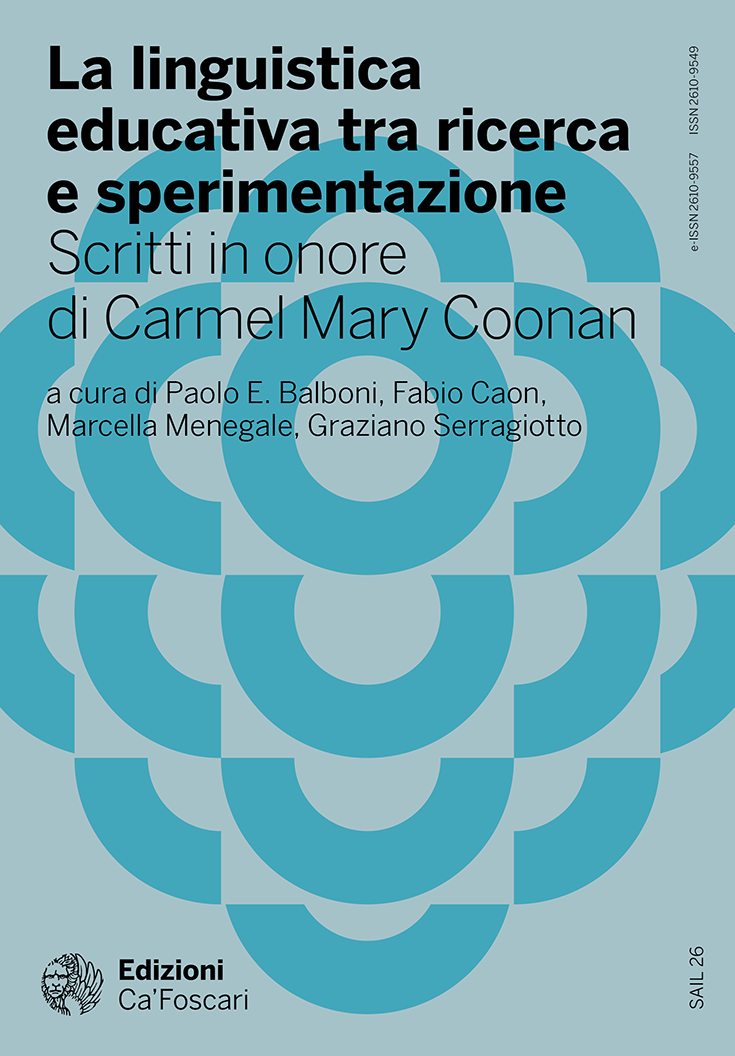Series |
SAIL
Volume 26 | Edited book | La linguistica educativa tra ricerca e sperimentazione
La linguistica educativa tra ricerca e sperimentazione
Scritti in onore di Carmel Mary Coonan
open access-
edited by
- Paolo E. Balboni - Università Ca’ Foscari Venezia, Italia - email orcid profile
- Fabio Caon - Università Ca’ Foscari Venezia, Italia - email orcid profile
- Marcella Menegale - Università Ca’ Foscari Venezia, Italia - email
- Graziano Serragiotto - Università Ca’ Foscari Venezia, Italia - email
Abstract
The volume collects the contributions of academics from various Italian universities who have worked with Carmel Mary Coonan throughout her career at Ca’ Foscari University. Starting from the themes that have characterised Carmel’s research interests, including Content and Language Integrated Learning (CLIL), professional development for language teachers and action research practice, the volume opens up to original methodological reflections and new lines of research in the field of educational linguistics. The relevance and variety of the studies here described confirm the lively and dynamic character of research and experimentation that shape our discipline. By questioning different language learning environments (both inside and outside language classroom), educational contexts (from kindergarten to university and beyond) and subjects (students as well as teachers), the volume highlights significant gains achieved in the field of language teaching and learning so far. At the same time, however, it makes clear the urge to further boost plurilingualism in language education, a goal that Carmel has tenaciously pursued throughout her whole career.
Keywords Museum • Emotions • Out-of-school • Adulti immigrati • Needs analysis • Glottotecnologie • Acquisition • Glottogeragogic model • Input flood • Italian as a Foreign language • Lower secondary school • Higher education • University students • Nursery school • Svantaggio • Phonology • Teacher training • Academic policy • Language teacher professional development • English Lingua Franca (ELF) • CLIL classroom discourse • Teacher cognition • Lavoro • Definition • Discourse markers (DM) • Online interaction • Plurilingualism • Educational linguistics • Cimbrian language • Insegnamento delle lingue minoritarie • Cooperative learning • Memory • Upper secondary school • Politica scolastica • EMI (English Medium Instruction) • Action-research • Language learning and teaching • Methodology • Horizontal learning • Italian as a Second language • Collaborative Professional Development • Apprendimento • Foreign language familiarisation • Object-based • Good practice • Language teaching • CLIL • Profilo del docente di lingue • Classroom-based research • Social mediation methodologies • FL teaching • Digital resources • Norvegese • Plurilingual approaches • Motivation • Vehicular language • Approcci e metodi glottodidattici • Educazione plurilingue • Minority language teaching • Socio-constructivist theories • Academic life • Educational Linguistics • Content-specific learning • Languages for specific purposes • Teachers’ training • L2/LS teaching • CLIL teacher profile • Pandemic effects • Core and non-core subjects • Argumentative skills • Knowledge sharing • Multiliteracies • Language education • Academic careers • English Medium Instruction (EMI) • Classroom interactions • CEFR • Intercomprehension (IC) • MALL (Mobile-assisted language learning) • Specialised terminology • Mentors and Masters • Autobiography • Multimodality • Case study • Academic Lecturing • Language learning • Native-speakerism • Implicit/explicit teaching
Permalink http://doi.org/10.30687/978-88-6969-683-1 | e-ISBN 978-88-6969-683-1 | ISBN (PRINT) 978-88-6969-684-8 | Number of pages 256 | Published April 28, 2023 | Submitted Jan. 9, 2023 | Language en, it
Copyright © 2023 Paolo E. Balboni, Fabio Caon, Marcella Menegale, Graziano Serragiotto. This is an open-access work distributed under the terms of the Creative Commons Attribution License (CC BY). The use, distribution or reproduction is permitted, provided that the original author(s) and the copyright owner(s) are credited and that the original publication is cited, in accordance with accepted academic practice. The license allows for commercial use. No use, distribution or reproduction is permitted which does not comply with these terms.
Parte I. Una disciplina in evoluzione
-
Introduzione
Scritti in onore di Carmel Mary Coonan - April 28, 2023
- Ordinari, Baroni, Maestri, Mentori
- April 28, 2023
- CLIL e professione per soggetti ‘svantaggiati’
- April 28, 2023
- La metodologia cooperativa come risorsa per il CLIL
- April 28, 2023
-
Memoria, emozioni, ricordi nell’invecchiamento
Implicazioni per l’educazione linguistica degli anziani - April 28, 2023
-
‘Di necessità, virtù’: insegnamento linguistico, tecnologia e ricerca-azione al tempo del COVID-19
Uno studio di caso - April 28, 2023
- La lingua straniera veicolare nella scuola dell’infanzia
- April 28, 2023
-
CLIL e intercomprensione in contesti minoritari
Un percorso glottodidattico per il cimbro di Luserna (TN) - April 28, 2023
-
L’insegnamento esplicito nello sviluppo della competenza pragmatica
Il caso dei segnali discorsivi - April 28, 2023
- EMI (English Medium Instruction) all’università: occasioni di confronto tra docenti disciplinaristi e linguisti educativi
- April 28, 2023
-
Comunicazione, mediazione e argomentazione in classe CLIL
Termini e definizioni nel discorso didattico - April 28, 2023
- CLIL e intercomprensione: due approcci compatibili al servizio della linguistica romanza
- April 28, 2023
- Il profilo dell’insegnante di lingue minoritarie, tra standardizzazione delle competenze e varietà dei modelli scolastici
- April 28, 2023
- Framing the Framework: Four Decades of Change in Language Teaching (and the Long March of ELF)
- April 28, 2023
-
Dal precettore a Duolingo: un’interpretazione linguistico-educativa e alcune considerazioni sul suo impiego e la sua efficacia
Il corso di norvegese - April 28, 2023
- La metodologia CLIL e l’italiano a stranieri
- April 28, 2023
- The Other Side of the Moon: Content-Specific Learning in CLIL in Core and Non-Core Subjects
- April 28, 2023
Parte II. Omaggio delle allieve
-
Bisogni e preoccupazioni del corpo docente impegnato in English Medium Instruction (EMI)
Una prospettiva italiana post-pandemia - April 28, 2023
-
Musei come luoghi ideali per l’apprendimento integrato di contenuti e lingua fuori dalla classe
Dalla ricerca sul CLIL al progetto MILE (Museums and Innovation of Language Education) - April 28, 2023
- Venti anni di CLIL in Italia
- April 28, 2023
